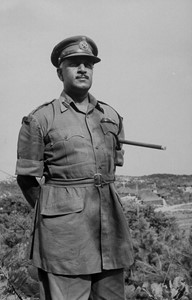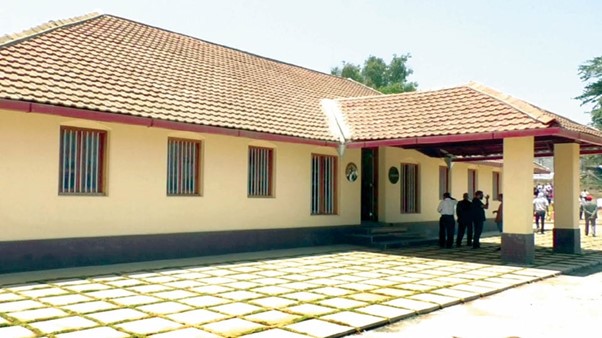
“A General Thimayya is not born in every generation. The likes of him there will seldom be a soldier. The General is a man’s man, the Army his soul and his soul the Army”
Lieutenant General Premindra Singh Bhagat, VC
Kodava are a unique race of people who live in Kodagu, the smallest district in Karnataka, which the British named as Coorg. This community of warriors lived on the slopes of the Western Ghats of South India from time immemorial. This landowning community known for its martial traditions has a distinct culture that is strikingly different from that of the neighbouring ones.
Kodavas are basically ancestral and nature worshippers. Every Kodava is a member of a patrilineal akka (clan) that has descended from a common ancestor. Karanava, the first ancestor of the clan is revered as a God and Kodavas worship the ancestral spirit, their Guru Karona.
Field Marshal Kodandera “Kipper” Medappa Cariappa OBE of Kodava Clan was the first Commander-in-Chief of the Indian Army.
Kodandera Subayya Thimayya was born in Madikeri, the district town of Kodagu on 31 March 1906, in the same clan as General Cariappa – The Kodandera.
His family was one of the leading coffee planters in the area. Thimayya, born to Subayya and Cheppudi Chittauwa, was the third of six children in his family. All the three boys Ponappa, Thimayya and Somayya of the family rose to become officers in the Indian Army.
His family sent Thimayya, at the age of eight years, to St. Joseph’s College in Coonoor, a convent run by Irish brothers. Later, Thimayya was sent to Bishop Cotton Boys’ School in Bangalore. After completing school, Thimayya went to the Prince of Wales Royal Indian Military College, a necessary stepping stone for a commission in the Indian Army. Following his graduation from RIMC, “Timmy”, as he was affectionately known, was one of only six Indian cadets selected for further training at the Royal Military College, Sandhurst.
After completing his training, he was commissioned into the Indian Army on 4 February 1926 as a Second Lieutenant. Thimayya was subsequently attached to the Highland Light Infantry as was the norm then, prior to a permanent posting with a regiment of the British Indian Army. He was soon posted to the 4th Battalion of the 19th Hyderabad Regiment (now Kumaon Regiment), with date from 28 May 1927. Appointed the regimental adjutant in September 1930, Thimayya honed his soldiering skills on that famous training ground in the Northwest Frontier (present-day Pakistan), battling recalcitrant Pathan tribals.
In January 1935, Thimayya married Nina Cariappa. On 20 March 1936, they had a daughter, Mireille. His wife, Nina Thimayya, was a recipient of the Kaisar-e-Hind medal for her philanthropic contribution during the 1935 Quetta earthquake. The same April, Thimayya was posted as an Adjutant at the University Training Corps in Madras, as a fitting example for young Indian undergraduates interested in joining the Indian Army, of what a good soldier should be.
Second World War
After this tenure, Thimayya was posted to his battalion in Singapore. In early 1941, he was promoted to the acting rank of Major and at his request, was transferred to India in October. Thimayya was posted as the Second-in-Command of a new raising at the Hyderabad Regimental Centre in Agra. He was then detailed to attend the Staff College at Quetta where he and his wife had earlier made a name for themselves by selfless service during the 1935 Quetta earthquake. He then served as GSO2 (Ops) (a Grade II Staff Officer) of the 25th Indian Division, the first Indian officer to get this coveted staff appointment.
His infantry division was conducting jungle warfare training and was preparing to go into Burma to face the Japanese Army during the Second World War, serving in the Second Arakan campaign. In Burma, he was posted to his old regiment as Commanding Officer of 8/19th Hyderabad, which he led with outstanding success in battle. For a short while, the battalion was under the command of the 3rd Commando Brigade, with Brigadier C. R. Hardy at the helm, who during the height of a battle presented a trophy to the battalion. It was a green beret – the command’s headdress – with a little typed message on a card, “We cannot buy anything here but we would like you to accept this as a token of our great admiration for the bravery and achievement of your battalion.” For his outstanding service in battle, he was awarded the much-coveted Distinguished Service Order (D.S.O) and also a Mention-in-Dispatches.

Thimayya represented the country during the surrender of the Japanese in Singapore, followed by the surrender of the Japanese in the Philippines. At the ceremony of the Japanese surrender in Singapore, he signed on behalf of India. He was awarded the ‘Keys to Manila’ when he was sent to the Philippines. His innate talents of professional soldiering and leadership were soon recognized by Field Marshal Sir Claude Auchinleck, the Commander-in-Chief of the Indian Army. He was specially selected to lead the 268th Indian Infantry Brigade as part of the British Commonwealth Occupation Force in Japan after World War II. He got this assignment due to his outstanding battle experience as a Brigadier and being the only Indian to command a battle formation in the field. As a matter of policy, the British avoided giving an operational command to Indians. Thimayya was the only exception.
As an independent brigade, the 268th had done excellent work in the Burma Campaign and was detailed as part of BRINDIV led by Maj Gen D. T. “Punch” Cowan. Brigadier Thimayya proved to be an outstanding commander and his diplomatic skills emerged as he had to deal with General Douglas MacArthur, the Supreme Allied Commander of the Southwest Pacific Theatre, the other Allies and the vanquished Japanese. Thimayya’s personality, charm of manners and unassailable reputation, impressed the Japanese of the calibre of Indian commanders. Thimayya was called on to defuse the sit-down strike by the 2nd Battalion, 5th Royal Gurkha Rifles at the palace of the Emperor of Japan in Tokyo when the battalion refused to obey its British officers.
As Indian Independence approached, he was recalled to India by then Commander-in-chief of British India, Field Marshal Sir Claude Auchinleck. He returned to India in 1947, during the Partition, as a member of the committee to agree to the allotment of weapons, equipment and regiments that were to remain in India or to be allotted to Pakistan. Soon after the commission was completed, he was promoted to the acting rank of Major-General in September 1947 and was then assigned the command of the 4th Infantry Division and also to take over the Punjab Boundary Force, dealing with the exodus and intake of refugees fleeing to their respective countries.
In 1948, he was one of the active officers in the actions against the forces of Pakistan in the conflict over Kashmir. His next appointment was the command of the 19th Infantry Division in Jammu & Kashmir where he succeeded in driving the raiders and the Pakistan Army out of the Kashmir Valley. Personally leading the attack in the forward-most tank, the surprise attack on Zoji La on 1 November 1948 by a brigade with Stuart Light Tanks of the 7th Light Cavalry, succeeded in driving out the entrenched raiders and Pakistan Army regulars and the eventual capture of Dras, Kargil and Leh.
Thereafter, Thimayya served as the Commandant of the Indian Military Academy, Dehra Dun. On 1 January 1950, he was promoted to substantive major-general from his rank of brigadier. On 1 October 1951, Thimayya was appointed Quartermaster General.
The experience gained by him in Japan stood him in good stead when he was specially selected by the United Nations to head the Neutral Nations Repatriation Commission in Korea. It was a very sensitive and delicate task dealing with unruly Chinese and Korean prisoners. Here again, through sheer charisma, impartiality, firmness and diplomacy, he completed this task to the satisfaction of the world body.
He returned to India and was promoted to General Officer Commanding-in-Chief, Southern Command, with the rank of Lieutenant-General, in January 1953. In 1954, he was awarded the Padma Bhushan for Civil Service. He took over the reins of the Indian Army on 7 May 1957.
General Kodandera Subayya Thimayya assumed charge of the Indian Army, as the 6th Chief of the Army Staff, on 7 May 1957. He briefly resigned his post in 1959 over a dispute with V. K. Krishna Menon, the then Minister of Defense (India). Prime Minister Jawaharlal Lal Nehru refused to accept his resignation and persuaded him into withdrawing it. However, little action was taken on Thimayya’s recommendations and he continued as the Army Chief till his retirement on 7 May 1961, completing 35 years of distinguished military service. Hence retired from the army in 1961, almost 15 months before the Chinese invasion of India in November 1962.
After retirement from the Indian Army, the United Nations sought his services yet once again when he was appointed as the Commander of UN Forces in Cyprus (UNFICYP) in July 1964. He died during his tenure at UNFICYP in December 1965 and his mortal remains were flown to Bangalore for the last rites.
General Thimayya’s house “Sunny Side” in Madikeri has been converted into a museum and a war memorial. It was inaugurated in February 2021 in the presence of the President and Chief of Defense Staff.

Great compilation and wonderful account of a brave hero Gen. Thimayya . My salutations …
LikeLike